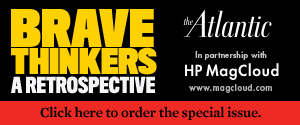Many are dismissing the new breast cancer recommendations as a hasty reversal of years of authoritative medical advice. But evidence weighing against screenings for women in their 40s has in fact been mounting for years.
Rethinking the Mammogram Guidelines
In January 2002, Umea, Sweden was about the coldest inhabited place on earth. But it was at Umea University, in an office festooned with Sweden's ubiquitous winter candles, that Lennarth Nystrom was carrying out his critical research: analyzing and updating the half-dozen Swedish mammography studies that tell us nearly all of what we know about the value of that procedure.
Sweden is the birthplace of mammography, and the Swedish mammography trials, which have monitored some 265,000 women in Malmo, Stockholm, Goteborg and other Swedish cities for nearly 30 years, are accepted by physicians and researchers worldwide as the most authoritative.
When I visited Nystrom that frigid winter, he and several distinguished Swedish colleagues were preparing to publish a periodic update of five of the six major Swedish trials.
Their conclusion, which the update itself called "surprising": there was "virtually no" benefit from mammograms for women under 55.
That was more than seven years ago.
Much of the confusion and controversy spawned by this week's report, by a government-sponsored task force, that screening mammograms are not helpful and may be harmful for women under age 50, has to do with the apparent suddenness of the decision, reversing a quarter-century of advice to begin annual screening at age 40.
But while the report is new, the underlying data has been available since March of 2002, when The Lancet, a widely respected British medical journal, published the Swedish update, known as a meta-analysis—a statistical procedure in which the results of the five independent trials were added together to mimic one gargantuan trial.
Although I wrote about the update on the front page of the Chicago Tribune, I was the only American reporter at the accompanying Stockholm news conference. The American Cancer Society, and the American College of Radiology, whose members make their living reading mammograms, continued to urge women to begin annual mammograms at age 40.
Now that the task force has changed its recommendation, it seems possible that billions of health-care dollars may have been misspent on mammograms for women under 50—or, according to the Swedish update, under 55—that were either unnecessary, or which caused women needless psychic and physical trauma.
Granted, biostatistics are not easy to understand, and harder to explain to a lay audience. But the current controversy over the task force's report owes much to the media's confusing coverage, some of which has been misinformed, including by TV doctors who ought to know better.
The confusion has been abetted by the American Cancer Society, whose position appeared to have softened, then hardened again, in recent weeks.
Last month, Dr. Otis Brawley, the cancer society's chief medical officer, was quoted in the New York Times admitting "that American medicine has overpromised when it comes to screening. The advantages to screening have been exaggerated.''
Another Times article quoted Dr. Susan Love, a leading breast surgeon, calling the under-50 question “the third rail” and praising Brawley for questioning the status quo.
“I really don’t think we should be routinely screening women under 50,” Love told the Times. “There’s no data showing it works.”
I wasn't surprised by Brawley's statement, since he had expressed the same view to me when we met at a cancer symposium in Milan in 2003. Following the task force report's release, however, Brawley appeared to change direction, telling The Times that the cancer society had concluded that the benefits of annual mammograms beginning at 40 "outweighed the risks" and that the ACS was sticking by its earlier advice.
"He's trying to save his job," one of Brawley's colleagues said. "He was broiled at home for the interview in which he said that we (the medical establishment) are 'overselling' screening."
In his recent comments, the ACS's Brawley has repeated that regular screening mammograms reduce the incidence of breast cancer in women age 40 to 50 by 15 percent—the same finding as the seven-year-old Swedish update. It should be noted that before the update, mammography advocates had been claiming that regular mammograms could reduce the risk of dying from breast cancer by a whopping 30 percent. The update knocked that number down, putting the benefit for women age 40 to 74 at 20 percent, a number The Lancet described as "modest," and for women 40-49 at 15 percent.
Thirty percent, 20 percent, and even 15 percent sound like large numbers. Women can be forgiven for asking why a procedure that offers a 15 or 20 percent better chance of surviving breast cancer should be put on the shelf. But even the 15 percent figure is in question.
Dr. Donald Berry, head of biostatistics at the M.D. Anderson Cancer Center in Houston, points out that if the Swedish update is read carefully, the benefit for women 40-50 is really only 9 percent, which is not statistically significant — meaning it could represent the play of chance and not a real advantage.
What Brawley and other mammography advocates flashing across TV screens lately have failed to mention is that the numbers they are flinging around are the relative benefit. Utterly obscured is the number that really matters, the absolute benefit (Brawley did not respond to an email requesting comment).
Once the difference is understood, it's much easier to see how little advantage is derived from screening mammograms. For example, the relative survival benefit of 20 percent among women 40-74 who had mammograms in the Swedish trials translates to 511 women dead of breast cancer out of 130,000 who were screened for 15 years—a death rate of 0.4 percent.
Among the comparison group of 117,000 Swedish women who did not have mammograms, the breast cancer death count was 585 women, or 0.5 percent. True, that’s a 20 percent relative benefit in favor of mammography. But 0.4 and 0.5 are very tiny numbers.
M.D. Anderson's Berry, who co-authored a companion paper to the task force report, calculates that a decade of mammograms in a woman's 40s increases her lifespan by an average of 5 days .
"The estimated average of 5 days of life lost if a woman in her early forties delays mammography for 10 years is similar to that for riding a bicycle for 15 hours without a helmet (or 50 hours if wearing a helmet)," Berry says, or of "gaining two ounces of body weight (and keeping them on)." (The only lifestyle feature that appears to correlate with breast cancer risk is obesity.)
Given the intensive, virtually nationwide breast cancer screening underway in Sweden, one would expect that country's breast cancer death rate to have fallen precipitously over the past two decades. But between 1990—the year regular mammograms became available to nearly all Swedish women—and 1998, Sweden's national breast cancer death rate fell by a scant 2 percent, or less than one fewer death in every 100,000 women.
Largely due to the publicity campaigns surrounding "early detection" for breast cancer, there is an inclination to see mammography as a lifesaving procedure with no downside. And women whose breast cancers were found via a mammogram and lived to tell the story are often convinced the mammogram saved their lives.
Such thinking is understandable. But breast tumors, not fatal by themselves, can metastasize to the lungs or other vital organs before they are large enough to be discovered by a mammogram—in which case the women is likely to die whether she has a mammogram or not.
Also frequently overlooked is the fact that mammograms pick up not only malignant tumors but all manner of benign cysts, masses and other anomalies that must then be investigated. The results of such findings can be both traumatic and costly.
Another Lancet study concluded that for every 10,000 mammograms given to apparently healthy women, doctors will order an average of 647 "diagnostic" mammograms, which are more painstaking and expensive, to re-examine something that appeared suspicious the first time around.
Determining which of those women have cancer, The Lancet said, also will require 358 breast examinations by ultrasound; 313 biopsies, including 209 in which part of the breast containing the abnormality is surgically removed, and 500 additional doctor's office visits.
The decision health insurers—and federal legislators—must now face is whether spending billions of dollars each year on mammograms and their subsequent procedures is the best use of scarce resources, or if those billions should be spent in some other way that could prevent even more deaths, such as intensive nationwide smoking cessation programs that would attack the major cancer killer among women.
The task force report also ignited a flap with its recommendation that, after years of being exhorted to examine their breasts monthly in the shower, women can now forget about self-exams. In response we have heard from women who discovered their breast tumors in the shower and lived to join the ranks of breast cancer survivors. And it’s true that most breast tumors are discovered by women themselves, rather than by mammograms.
But as with mammography, discovering a breast tumor with a self-exam is no guarantee that the patient will live to tell about it. Rather than looking at anecdotal cases, the benefits of self-exams are best understood by observing large and statistically significant populations of women. In 2002, the same year the Swedish update was published, the final results were made available from a huge and careful trial involving more than 260,000 female Shanghai factory workers—a near-perfect homogenous and regimented environment in which to conduct such a study.
Half the women, chosen at random, were taught by trained nurses to do breast self-exams. The other half were not. After more than a decade, there was no difference in cancer mortality between the groups.
So much for breast self-examination. But doctors and nurses either ignored the Chinese study or, more likely, were unaware of it. As a result, more seven-year-old data is now being passed off as a sudden paradigm shift.
There are multiple reasons women are ill-informed about breast cancer. The fault lies primarily with their physicians, the cancer establishment, and the news media—especially the news media. Until coverage of breast cancer rises above the level of scary warnings mixed with heartwarming stories of cancer survivors, women are likely to go on being perplexed.
John Crewdson spent 37 years as a correspondent for the Chicago Tribune and The New York Times, where he won a Pulitzer Prize for National Reporting
Article Toolssponsored by: |
|
|



















